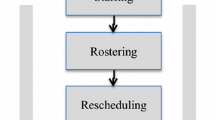Abstract
Although nursing is physically and mentally strenuous, only a few studies have been done to find the impacts of the fatigue level and nursing workflow corresponding to major healthcare activities in an intensive care unit (ICU). To address this need, the current study aims to understand the relationships among the key nursing activities that impact their fatigue levels in ICU. Nurses’ time-study and real-time location data have been used to develop a simulation model in two different periods: February to March 2020 and July 2020. Two Hierarchical Task Analysis charts were developed from the collected data, one for each period, and used as the foundation for the fatigue-recovery simulation model. Different scenarios of all nursing activities’ frequencies (number of conducted tasks during a shift) and task sequences (number of times tasks are conducted continuously prior to a break) were simulated in order to understand their impact on nurses’ predicted average fatigue level reached in a shift. According to the results, the performing procedure, patient care, and peer support activities stand out as the most crucial drivers for fatigue during a nurse shift in an ICU.
Access this chapter
Tax calculation will be finalised at checkout
Purchases are for personal use only
Similar content being viewed by others
References
Moghadam, K.N., et al.: Nursing workload in intensive care units and the influence of patient and nurse characteristics. Wiley. British Association of Critical Care Nurses (2020)
Sagherian, K., Clinton, M.E., Huijer, H.A., Geiger-Brown, J.: Fatigue, work schedules, and perceived performance in bedside care nurses. Workplace Health Saf. 65(7), 304–312 (2017)
Song, X., Kim, J.H.: A time-motion study in an intensive care unit using the near field electromagnetic ranging system. In: Industrial and Systems Engineering Conference (2017)
Kolodziej, K.W., Hjelm, J.: Local Positioning Systems: LBS Applications and Services, p. 95. CRC/Taylor & Francis, Boca Raton (2006)
Åhsberg, E.: Perceived fatigue related to work. Ph.D. diss, University of Stockholm, Sweden (1998)
Dode, P., Greig, M., Zolfaghari, S., Neumann, W.P.: Integrating human factors into discrete event simulation: a proactive approach to simultaneously design for system performance and employees’ well being. Int. J. Prod. Res. 54(10), 3105–3117 (2016). Department of Mechanical and Industrial Engineering, Ryerson University, Toronto, Canada
Givi, Z.S., Jaber, M.Y., Neumann, W.P.: Modelling worker reliability with learning and fatigue. Department of Mechanical and Industrial Engineering, Ryerson University, Toronto, Canada. Elsevier (2015)
Jaber, M.Y., Givi, Z.S., Neumann, W.P.: Incorporating human fatigue and recovery into the learning–forgetting process. Appl. Math. Model. 37(12–13), 7287–7299 (2013)
Vargas, V., Kim, J.H.: Learning-forgetting-fatigue-recovery simulation model. In: Wright, J.L., Barber, D., Scataglini, S., Rajulu, S.L. (eds.) AHFE 2021. LNNS, vol. 264, pp. 135–142. Springer, Cham (2021). https://doi.org/10.1007/978-3-030-79763-8_16
Schantz, H.G.: A real-time location system using near-field electromagnetic ranging. In: IEEE Antennas and Propagation Society International Symposium (2007)
Schantz, H.G., Weil, C., Unden, A.H.: Characterization of error in a near-field electromagnetic ranging (NFER) real-time location system (RTLS). In: IEEE Radio and Wireless Symposium (2011)
Staton, N.A.: Hierarchical task analysis: developments, applications and extensions. Applied Ergonomics 37, 55–79 (2006). Human Factors Integration Defense Technology Centre, School of Engineering and Design, Brunel University, UK
Barnes, C.D., Laughery Jr., K.R.: Advanced uses for micro saint simulation software. In: 29th Conference on Winter Simulation (1997)
Bodilsen, J., et al.: Hospital admission and mortality rates for non-covid diseases in Denmark during covid-19 pandemic: nationwide population based cohort study. BMJ 373, n1135 (2021)
Allison, M.C., et al.: Lockdown britain: evidence for reduced incidence and severity of some non-COVID acute medical illnesses. Clin. Med. (Lond.) 21(2), e171 (2021)
Lemiere, C., Begin, D., Camus, M.: Occupational risk factors associated with work-exacerbated asthma in Quebec. Occ. Health Environ. Med. 69, 901–907 (2012)
Santi, L., et al.: Non-COVID-19 patients in times of pandemic: emergency department visits, hospitalizations and cause-specific mortality in Northern Italy. PloS One 16(3), e0248995 (2021)
Huang, L., Lin, G., Tang, L., Yu, L., Zhou, Z.: Special attention to nurses’ protection during the COVID-19 epidemic. Crit. Care 24, 120 (2020)
Author information
Authors and Affiliations
Corresponding author
Editor information
Editors and Affiliations
Rights and permissions
Copyright information
© 2022 The Author(s), under exclusive license to Springer Nature Switzerland AG
About this paper
Cite this paper
de Oliveira Vargas, V., Kim, J.H., Despins, L., Kasaie, A. (2022). Simulation Model to Understand Nurses’ Fatigue Level in an Intensive Care Unit. In: Duffy, V.G. (eds) Digital Human Modeling and Applications in Health, Safety, Ergonomics and Risk Management. Health, Operations Management, and Design. HCII 2022. Lecture Notes in Computer Science, vol 13320. Springer, Cham. https://doi.org/10.1007/978-3-031-06018-2_12
Download citation
DOI: https://doi.org/10.1007/978-3-031-06018-2_12
Published:
Publisher Name: Springer, Cham
Print ISBN: 978-3-031-06017-5
Online ISBN: 978-3-031-06018-2
eBook Packages: Computer ScienceComputer Science (R0)




